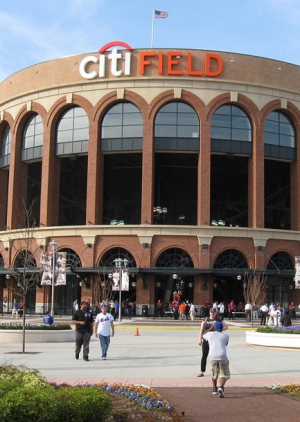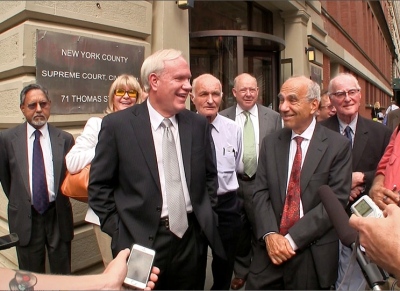Did state really OK Flushing Meadows shopping mall in 1961?

Developers cite a 1961 law as permission for building a shopping mall next to Citi Field on official city parkland.
Full disclosure: The author of this article is president of the Jackson Heights Beautification Group, a civic and environmental nonprofit that has contributed funding for the lawsuit opposing the shopping mall at Flushing Meadows-Corona Park.
By Len Maniace
The David and Goliath dispute over whether developers can build a mammoth shopping mall on city parkland that’s served as the New York Mets’ parking field finally got its day in court yesterday.
Arrayed on one side were New York City and the developers, Related Companies and Mets owner Sterling Equities. Three attorneys, including former Chief Judge of the New York State Court of Appeals Judith Kaye, presented that case. The other side – a group of nonprofit organizations, local businesses, residents and state Senator Tony Avella – were represented by a single attorney.
No decision was reached yesterday, but the hearing provided a dramatic glimpse of a major New York City land-use battle at Flushing Meadows-Corona Park worth billions of dollars.
And based on the arguments heard by state Supreme Court Justice Manuel Mendez, the case could be decided on issues such as: whether shopping could be considered “recreation, entertainment, amusement,” and whether the state Legislature’s 1961 permission for a portion of the park to be used for a Mets’ stadium and parking, amounts to “direct and specific approval” for a 1.2 million square foot shopping mall.
The developers argued yes on both points, yesterday.
“People go to shopping centers and malls for entertainment and recreation and amusement,” contended attorney Jonathan Frank.
Attorneys for the city and the developers contended that their plan complied with seven uses cited in a 1961 state law allowing a portion of Flushing Meadows to be used to build a stadium and parking field while remaining official New York City parkland. The lawyers, however, focused not on the land remaining park space, but on a section of the law allowing for uses that:

Mall opponents talk to press after court hearing. Fom left: Harbachan Singh, Queens Civic Congress; Irene Prestigiacomo, Willets Point United; state Senator Tony Avella; Joseph Ardizzone, Willets Point United; Michael Gruen, City Club of New York; John Low-Beer, plaintiffs’ attorney; Ben Haber, activist/plaintiff; Copyright 2014 LoScalzo Media Design LLC.”
…provide for the benefit of the people of the city, recreation, entertainment, amusement, education, enlightenment, cultural development or betterment, and improvement of trade and commerce, including professional and amateur scholastic sports and athletic events, theatrical, musical or other entertainment presentations, and meetings, assemblages and conventions and exhibitions for any purpose…
The developers contend the phrase “improvement of trade and commerce,” also allows for construction of the mall.
The developers’ lawyers buttressed their case – and indeed spent much of their time – pointing to their redevelopment plan for a nearby site that contained several hundred small auto-related businesses. A mall on the Citi Field parking field would generate enough money to finance that otherwise separate housing and a hotel project on a site that’s long been targeted by the city for redevelopment.
The mall-opponents’ attorney John Low-Beer, however, was quick to point out the redevelopment of the auto-related businesses on Willets Point was not the issue before the court.
“This maybe the greatest project since sliced bread, but the city still has to follow the law,” said Low-Beer, referring to the housing and hotel project on Willets Point.
The mall-plan critics’ lawsuit boils down to three main points: that the city failed to get state Legislature approval for what’s known as alienation of parkland; that the land must be rezoned before any non-park use can take place; and that any city lease of the land or rezoning requires a city planning review known as the Uniform Land Use Review Procedure, which did not take place.
The intent of 1961 state law, Low-Beer maintained, was not to permit a shopping mall on the site, but to serve as a vehicle allowing for construction of the stadium and parking field. The land, he noted, remained as parkland.
“Shopping may be great fun, but it is not a public purpose,” Low-Beer said.
Low-Beer noted that converting parkland to a non-park purpose requires a special act by the state legislature. He pointed to a 2001 case requiring the city to go through that procedure in order to build a water treatment plant in Van Cortland Park in the Bronx, even though the land would eventually be returned for park purposes.
The decision in that case by the state’s highest court, the Court of Appeals, read in part:
Our law is well settled: dedicated park areas in New York are impressed with a public trust for the benefit of the people of the state. Their use for other than park purposes, either for a period of years or permanently, requires the direct and specific approval of the State Legislature, plainly conferred.
That decision was written by Kaye, then the court’s Chief Judge, and Low-Beer argued that it clearly upheld his position in this case. Kaye argued that the decision was not in conflict with the developers’ position because of the 1961 law.
The mall supporters have two weeks to submit further legal arguments on the lawsuit, after which Justice Mendez will issue a ruling.